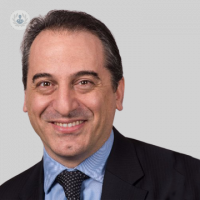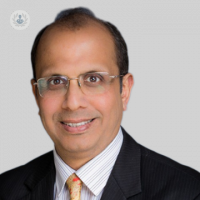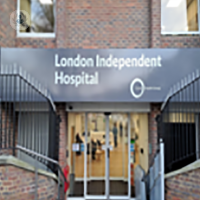What is a gastric band?
Gastric band is a technique used in bariatric surgery (weight loss surgery). Bariatric surgery aims to reduce the amount of food or calories the patient eats via operations on the upper digestive system (particularly the stomach), which physically and psychologically affect the patient’s approach to food.
A gastric band is a device placed around the upper part of the stomach, creating a small pouch at the top. As there is less space for food in this pouch, the patient gets full quicker when eating, and so eats less.
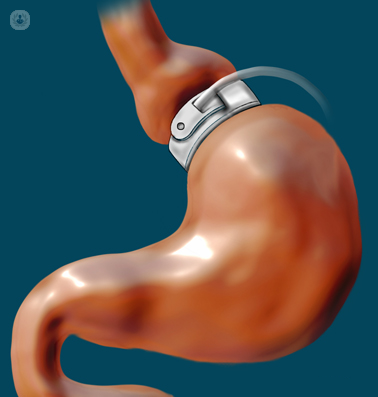
Why would you have a gastric band?
Gastric bands are principally used to treat obesity, and also can be used to treat type 2 diabetes, sleep apnoea and hypertension. The idea is to force the patient to eat less or reduce calorie intake, so it may be an option in treating any condition that is negatively affected by overeating.
Surgical options for weight loss are usually not the first choice of treatment, as losing weight through exercise or dietary change carries minimal risk. However, if this doesn’t work, your doctor may discuss surgical options, such as installing a gastric band.
What does it involve?
The patient is given general anaesthetic to put them to sleep and prevent them from feeling pain during the surgery. Gastric bands are usually implanted using laparoscopy – a minimally invasive surgical technique utilising small incisions, through which a tiny camera is inserted to allow the surgeon to see inside the body. The surgery is then performed by inserting the instruments needed through these small incisions, rather than creating large incisions.
The surgeon places the band around the stomach, creating a small pouch in the top half, with a narrow “bottle-neck” for food to drain into the larger lower section of the stomach. The operation may only take half an hour to an hour if your surgeon is experienced with the procedure. Installing a gastric band doesn’t involve any cutting or stapling inside the body.
A small device connected to the band is placed under the skin (usually in the middle of the chest), which allows your doctor to tighten the band after the surgery is complete. This is usually done for the first time about four to six weeks after surgery. It is usually tightened a few times until the ideal tightness is found.
Is it safe to have a gastric band?
There are always certain risks when undergoing surgery, but as it doesn’t involve any cutting inside the body, and (when performed via laparoscopy) only small incisions are made on the outside, gastric band surgery is generally regarded as the safest surgical weight loss procedure, carrying less risk than a gastric bypass or a sleeve gastrectomy.
The other advantage is that gastric bands are removable, so if there are complications, the procedure can be reversed.
01-07-2013 05-23-2023Gastric band
Professor Francesco Rubino - Surgery
Created on: 01-07-2013
Updated on: 05-23-2023
Edited by: Sophie Kennedy
What is a gastric band?
Gastric band is a technique used in bariatric surgery (weight loss surgery). Bariatric surgery aims to reduce the amount of food or calories the patient eats via operations on the upper digestive system (particularly the stomach), which physically and psychologically affect the patient’s approach to food.
A gastric band is a device placed around the upper part of the stomach, creating a small pouch at the top. As there is less space for food in this pouch, the patient gets full quicker when eating, and so eats less.

Why would you have a gastric band?
Gastric bands are principally used to treat obesity, and also can be used to treat type 2 diabetes, sleep apnoea and hypertension. The idea is to force the patient to eat less or reduce calorie intake, so it may be an option in treating any condition that is negatively affected by overeating.
Surgical options for weight loss are usually not the first choice of treatment, as losing weight through exercise or dietary change carries minimal risk. However, if this doesn’t work, your doctor may discuss surgical options, such as installing a gastric band.
What does it involve?
The patient is given general anaesthetic to put them to sleep and prevent them from feeling pain during the surgery. Gastric bands are usually implanted using laparoscopy – a minimally invasive surgical technique utilising small incisions, through which a tiny camera is inserted to allow the surgeon to see inside the body. The surgery is then performed by inserting the instruments needed through these small incisions, rather than creating large incisions.
The surgeon places the band around the stomach, creating a small pouch in the top half, with a narrow “bottle-neck” for food to drain into the larger lower section of the stomach. The operation may only take half an hour to an hour if your surgeon is experienced with the procedure. Installing a gastric band doesn’t involve any cutting or stapling inside the body.
A small device connected to the band is placed under the skin (usually in the middle of the chest), which allows your doctor to tighten the band after the surgery is complete. This is usually done for the first time about four to six weeks after surgery. It is usually tightened a few times until the ideal tightness is found.
Is it safe to have a gastric band?
There are always certain risks when undergoing surgery, but as it doesn’t involve any cutting inside the body, and (when performed via laparoscopy) only small incisions are made on the outside, gastric band surgery is generally regarded as the safest surgical weight loss procedure, carrying less risk than a gastric bypass or a sleeve gastrectomy.
The other advantage is that gastric bands are removable, so if there are complications, the procedure can be reversed.


Dear doctor, there’s something wrong with my gastric band
By Mr Giovanni D. Tebala
2025-02-01
Gastric bands can be very effective, but on rare occasions, they cause unpleasant symptoms for people and have to be removed. Mr Giovanni Tebala, a consultant colorectal, upper GI and laparoscopic surgeon explains to us what a gastric band removal procedure is like and why people have them. See more


"Why this is the best weight loss surgery for you – what I would choose for you as your obesity surgeon”
By Mr Ali Alhamdani
2025-01-31
There are many different things which must be considered when deciding on the right path to follow for weight loss surgery. Top surgeon Mr Ali Alhamdani explains how he decides the best course of action and procedure for the patient. See more
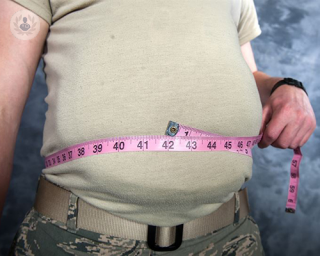

Should patients with GORD get a sleeve gastrectomy?
By Mr Ali Alhamdani
2025-01-30
If a patient with gastro-oesophageal reflux disease (GORD) wants bariatric surgery, there are certain extra risks to consider. Top bariatric surgeon Mr Ali Alhamdani speaks about his views on offering sleeve gastrectomy to these patients. See more


Which bariatric surgery is right for me?
By Mr Krishna Moorthy
2025-01-28
There are four common procedures in bariatric surgery, which may leave a patient questioning how to choose the correct surgery for their body. Our bariatric surgeon Mr Krishna Moorthy weighs in with his expert advice. See more
Experts in Gastric band
-
Professor Francesco Rubino
SurgeryExpert in:
- Gastric sleeve
- Diabetes surgery
- Bariatric surgery
- Obesity
- Gastric bypass
- Gastric band
-
Mr Sanjay Agrawal
SurgeryExpert in:
- Weight loss injections
- Obesity surgery
- Bariatric surgery
- Gastric band
- Gallstones
- Hernia
-
Mr Bart Decadt
SurgeryExpert in:
- Obesity surgery
- Gastric sleeve
- Gastric band
- Gastric bypass
- Acid reflux
- Gallbladder surgery
- See all

London Bridge Hospital - part of HCA Healthcare
London Bridge Hospital - part of HCA Healthcare
27 Tooley St
No existe teléfono en el centro.
By using the telephone number provided by TOP DOCTORS, you automatically agree to let us use your phone number for statistical and commercial purposes. For further information, read our Privacy Policy
Top Doctors

The London Independent Hospital - part of Circle Health Group
The London Independent Hospital - part of Circle Health Group
1 Beaumont Square, Stepney Green
No existe teléfono en el centro.
By using the telephone number provided by TOP DOCTORS, you automatically agree to let us use your phone number for statistical and commercial purposes. For further information, read our Privacy Policy
Top Doctors

The Alexandra Hospital - part of Circle Health Group
The Alexandra Hospital - part of Circle Health Group
Mill Ln, Cheadle, SK8 2PX
No existe teléfono en el centro.
By using the telephone number provided by TOP DOCTORS, you automatically agree to let us use your phone number for statistical and commercial purposes. For further information, read our Privacy Policy
Top Doctors
-
London Bridge Hospital - part of HCA Healthcare
27 Tooley St, Central LondonExpert in:
- 24-hour service
- Cardiology
- Minimal access surgery (keyhole surgery)
- Orthopaedic surgery
- Cardiovascular disease
- Gastroenterology
-
The London Independent Hospital - part of Circle Health Group
1 Beaumont Square, Stepney Green, East LondonExpert in:
- Cataracts
- Bariatric Surgery
- Maxillofacial Surgery
- Neurological spinal surgery
- Orthopaedic surgery
- Orthopaedic spinal surgery
-
The Alexandra Hospital - part of Circle Health Group
Mill Ln, Cheadle, SK8 2PX, CheadleExpert in:
- Hip
- Cardiology
- Shoulder and elbow
- Paediatrics
- Foot and ankle
- Knee
- Most viewed diseases, medical tests, and treatments
- Alzheimer's disease
- Nutrition
- Weight loss injections
- Nipple discharge
- Abdominal pain
- Endovenous laser treatment (EVLA)
- Minimal access surgery (keyhole surgery)
- Head and neck cancer
- Neck lump
- Bariatric surgery
